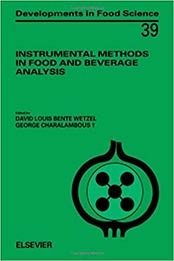
- Title: Instrumental Methods in Food and Beverage Analysis (Developments in Food Science) 1st Edition
- Autor: D.L.B. Wetzel, G. Charalambous
- Pages: 629
- Publisher (Publication Date): Elsevier Science; 1 edition (June 12, 1998)
- Language: English
- ISBN-10: 0444820183
- Download File Format: PDF
Advances in instrumentation and applied instrumental analysis methods have allowed scientists concerned with food and beverage quality, labeling, compliance, and safety to meet ever increasing analytical demands. Texts dealing with instrumental analysis alone are usually organized by the techniques without regard to applications. The biannual review issue of Analytical Chemistry under the topic of Food Analysis is organized by the analyte such as N and protein, carbohydrate, inorganics, enzymes, flavor and odor, color, lipids, and vitamins. Under ‘flavor and odor’ the subdivisions are not along the lines of the analyte but the matrix (e.g. wine, meat, dairy, fruit) in which the analyte is being determined.
In “Instrumentation in Food and Beverage Analysis” the reader is referred to a list of 72 entries entitled “Instrumentation and Instrumental Techniques” among which molecular spectroscopy, chromatographic and other sophisticated separations in addition to hyphenated techniques such as GS-Mass spectrometry. A few of the entries appear under a chapter named for the technique. Most of the analytical techniques used for determination, separations and sample work prior to determination are treated in the context of an analytical method for a specific analyte in a particular food or beverage matrix with which the author has a professional familiarity, dedication, and authority. Since, in food analysis in particular, it is usually the food matrix that presents the research analytical chemist involved with method development the greatest challenge.
![Food Analysis (Food Science Text Series) by S. Suzanne Nielsen [3319457748, Format: PDF] 3319457748](https://cookebooks.info/wp-content/uploads/2018/08/3319457748.jpg)
![Food Analysis (Food Science Text Series) 4th ed. 2010, Corr. 3rd printing 2014 Edition by S. Suzanne Nielsen [1441914773, Format: PDF] 1441914773](https://cookebooks.info/wp-content/uploads/2019/04/1441914773.jpg)
![Testing for Genetic Manipulation in Plants (Molecular Methods of Plant Analysis) Softcover reprint of hardcover 1st ed. 2002 Edition by John Flex Jackson, Hans F. Linskens [3642077307, Format: PDF] 3642077307](https://cookebooks.info/wp-content/uploads/2019/01/3642077307.jpg)
![Modern Techniques for Food Authentication 1st Edition by Da-Wen Sun [0123740851, Format: PDF] 0123740851](https://cookebooks.info/wp-content/uploads/2019/03/0123740851.jpg)
![Food Science and Food Biotechnology by Gustavo F. Gutierrez-Lopez [1566768926, Format: PDF] 1566768926](https://cookebooks.info/wp-content/uploads/2018/09/1566768926.jpg)
![Food Aroma Evolution by Matteo Bordiga, Leo M.L. Nollet [PDF: 1138338249] Food Aroma Evolution by Matteo Bordiga, Leo M.L. Nollet](https://cookebooks.info/wp-content/uploads/2020/01/1138338249.jpg)